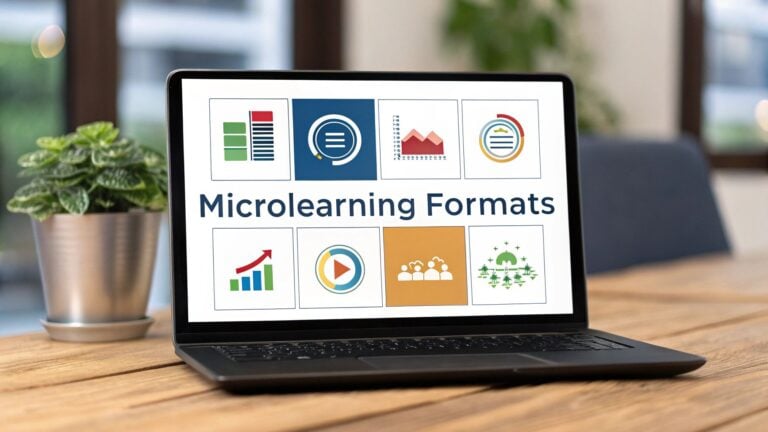Your Guide to Course Management Systems

A course management system is your digital command center for creating, organizing, and delivering any kind of educational content.
It’s the software that powers everything from huge university classes to your company’s internal training programs, all from one central spot.
What a Course Management System Actually Is
Have you ever taken an online course and wondered how everything felt so seamless and organized? That’s the work of a good course management system. I like to think of it as the digital campus for your entire learning community.
Let’s try an analogy.
Imagine all your course content, like your videos, PDFs, and quizzes, is the furniture for a new house.
A course management system is the architectural blueprint, the foundation, and the very rooms that give all that furniture a home and a purpose. It’s the framework that holds the entire learning experience together, making it simple for students to navigate and a breeze for me to manage.
Who Uses These Systems?
These platforms aren’t just for big universities anymore. Their use has exploded across different sectors because they solve a universal problem: how to organize and deliver learning material without pulling your hair out.
You’ll find them being used by:
- Educational Institutions: From K-12 schools all the way up to major universities, these systems are the standard for managing coursework, grades, and student communication.
- Corporate Trainers: Companies rely on them for everything from employee onboarding and compliance training to ongoing professional development. This ensures every team member gets consistent, high-quality information.
- Entrepreneurs and Creators: Solo business owners and small teams use them to sell their expertise through online courses on everything from coding to cooking.
This widespread adoption shows just how essential these tools have become.
In fact, the market for these platforms, often grouped under the broader term Learning Management System (LMS), is growing at a staggering pace. It was valued at USD 23.35 billion in 2024 and is projected to hit USD 82.00 billion by 2032.
That growth is being driven by a massive demand for learning experiences that are both interactive and mobile-friendly. You can dig into the specifics in the Fortune Business Insights’ report.
The core idea is simple. A course management system brings all your teaching and learning activities into one organized, online space. It removes the administrative headache so you can focus on what really matters: creating great content and engaging with your learners.
Seeing how others have built their programs can be incredibly inspiring and instructive.
If you’re curious about what these systems look like in the real world, you might be interested in our guide on learning management system examples. It offers a closer look at how different platforms are structured and used.
Essential Features of a Great System

Okay, so we’ve covered what a course management system is in broad strokes. But what separates the good from the truly great?
When you start comparing options, you’ll get hit with a tidal wave of marketing buzzwords, but the best platforms all deliver on a handful of non-negotiable, core features.
These are the tools you’ll rely on every single day to build, run, and scale your learning programs.
These are your practical, no-nonsense checklist for evaluating any system you’re thinking about bringing on board. It all begins with how you actually put your courses together.
Intuitive Course Authoring
The heart and soul of any course management system is its course builder. This is where your expertise comes to life.
A great system makes this process feel natural and straightforward, even if you’re not particularly tech-savvy. You shouldn’t need a computer science degree just to upload a video or create a simple quiz.
What I look for is a drag-and-drop interface that lets me easily map out lessons, upload all sorts of files like videos and PDFs, and even embed content from other websites.
The whole point is to spend my time crafting amazing educational material, not wrestling with clunky software.
- Content Uploads: Effortlessly add video, audio, slide decks, and documents.
- Lesson Structuring: Organize everything into logical modules and sections.
- Quiz Creation: Build assessments with multiple question types like multiple-choice, true/false, and short answer.
This kind of flexibility is crucial. It gives you the power to create a dynamic learning journey that keeps your students hooked from beginning to end.
Without a user-friendly builder, even the most brilliant content can become an administrative nightmare.
Robust Reporting and Analytics
How do you know if your course is actually landing with your audience? That’s where reporting and analytics come in.
A quality course management system gives you a clear window into how your learners are engaging with your material.
You need way more than just a list of who signed up. Look for features that track student progress, quiz scores, and course completion rates. This data is pure gold. It shows you which lessons are resonating, where students might be getting stuck, and how effective your assessments really are.
In the corporate world, a whopping 72% of organizations see learning analytics as a top priority for improving their training.
Good analytics transform your role from just a content creator to an informed instructor. You can use the data to refine your course, offer help to struggling learners, and prove the value of your training.
Communication and Community Tools
Learning is often a social experience, even when it happens online.
The best course management systems understand this and include tools to help you build a real community around your content. This is what separates a static, one-way information dump from a living, breathing learning environment.
Look for built-in features like:
- Discussion Forums: A dedicated space for learners to ask questions, share insights, and connect with each other.
- Direct Messaging: Lets you communicate privately with students to offer personalized support or feedback.
- Announcements: A simple way to broadcast updates and important information to all your learners at once.
These tools foster a sense of connection and collaboration, which can dramatically boost engagement and knowledge retention.
When students feel like they’re part of a community, they’re far more likely to stay motivated and see the course through to the end.
To pull all this together, let’s look at a quick breakdown of these must-have features and why they’re so important.
Essential Features of a Course Management System
This table lays out the core functionalities you should look for, what they do in plain English, and the real-world benefit they provide.
| Core Feature | What It Does | Why It’s Important |
|---|---|---|
| Course Authoring | Lets you create, structure, and upload all your course materials like videos, text, and quizzes. | It simplifies the content creation process so you can focus on quality teaching, not technical hurdles. |
| Reporting & Analytics | Tracks learner progress, completion rates, and assessment scores, providing actionable data. | It helps you measure the effectiveness of your course, identify areas for improvement, and support your students. |
| Communication Tools | Provides forums, messaging, and announcements to connect you with your learners and learners with each other. | It builds a strong learning community, which boosts engagement, motivation, and overall course satisfaction. |
Ultimately, a system that nails these three areas gives you a powerful foundation. It equips you not just to create a course, but to create a successful and engaging learning experience that delivers real results.
I understand that we’ve walked through the key features, but a simple list of tools doesn’t really capture the full story. Let’s talk about the why. What’s the real, tangible value you get from a good course management system? Why bother setting one up in the first place?
The answer is simple. It benefits everyone involved, both you as the creator, and the people you’re trying to teach.
One of the most immediate wins is accessibility. A course management system completely shatters geographical barriers.
Someone in a small town can now access the exact same high-quality training as someone in a major city. This opens your educational content to a truly global audience, something that’s flat-out impossible with traditional, in-person teaching.
Creating Consistency and Efficiency
For any organization, from a small business running compliance training to a large corporation onboarding new hires, consistency is everything.
A course management system is your guarantee that every single learner receives the same core information and materials, every single time. You can’t afford to have knowledge gaps, and this ensures you don’t.
And then there’s the massive efficiency boost. Just think about all the time and resources you currently sink into printing workbooks, booking training rooms, or manually chasing people to see who has completed what.
A CMS handles so much of this administrative grind for you.
- No more printing costs: All materials are digital, which is a win for your budget and the environment.
- Simplified scheduling: Learners dive into content on their own time, which puts an end to calendar Tetris.
- Automated tracking: The system generates progress reports and completion certificates on its own.
This frees you up to focus on what matters most. For the majority of people, that is creating better content and interacting with your students.
A course management system is like a tireless administrative assistant. It takes care of the repetitive, time-sucking tasks so I can invest my energy where it truly matters: in teaching and creating.
The demand for these kinds of efficient solutions is exploding. The global market for corporate Learning Management Systems, a close cousin to the course management system, was valued at around USD 12.02 billion in 2024.
Projections show it rocketing to nearly USD 72.30 billion by 2034. That figure, which you can read more about over at Precedence Research, reflects a monumental shift in how companies think about training and development.
Boosting Engagement and Retention
Perhaps one of the most powerful benefits is how these platforms can genuinely improve learning outcomes.
Let’s be honest, static content like a PDF document or a one-way video lecture can be pretty dry. A good course management system lets you build a far more interactive and engaging experience.
You can weave in quizzes, discussion forums, and assignments that nudge learners to actively use what they’ve just learned.
This kind of hands-on approach has been proven time and again to increase knowledge retention. When people are actively involved instead of just passively consuming information, the lessons actually stick.
For example, you could wrap up a module with a quick quiz to cement the key takeaways or spark a debate in a forum with a real-world case study. These simple additions transform learning from a lonely, solo activity into a dynamic, collaborative experience.
A Scalable and Measurable Solution
Finally, let’s talk about growth and data.
As a creator, I’d want my business to grow. A course management system is built for exactly that. Whether you have 10 students today or 10,000 next year, the system handles the load without demanding much extra work from you.
You can serve a virtually unlimited number of learners with the same core effort it takes to serve a handful. This incredible scalability is what makes online courses such a powerful and sustainable business model.
At the same time, everything is measurable. Your analytics dashboard becomes your source of truth, showing you exactly what’s working and what’s falling flat.
- Are students consistently dropping off at a particular lesson? It might be too long, too complex, or just plain confusing.
- Are they acing one quiz but bombing another? That’s a clear signal telling you where your teaching needs a bit more focus.
This data-driven feedback loop allows you to continuously refine your courses and prove their effectiveness to stakeholders, clients, or your learners themselves. It elevates your teaching from guesswork to a process of informed, strategic improvement.
Exploring the Different Types of Systems
Finding the right course management system can feel like walking into a massive hardware store with no idea what you’re looking for. The options seem endless, but they generally fall into a few key categories.
Getting a handle on these differences is the first real step toward picking a system that actually fits your needs, budget, and technical comfort zone.
The biggest fork in the road you’ll encounter is between cloud-based and self-hosted systems.
Going back to our analogy from the beginning, think of it like renting a fully furnished apartment versus building your own house from the ground up. One gets you moved in fast, while the other gives you total freedom, but also total responsibility.
Cloud-Based vs. Self-Hosted Systems
A cloud-based course management system, often called SaaS (Software as a Service), is like that apartment rental. You pay a monthly or annual fee, and the company handles all the technical heavy lifting for you.
This covers hosting, updates, security, and maintenance. You just log in and start creating. It’s the most popular choice for a reason: it’s incredibly simple to get started.
On the other hand, a self-hosted system is the “build your own house” route. You download the software, often for free if it’s open-source, but you’re on the hook for everything else.
In this scenario, you have to find and pay for your own web hosting, install the software, run every update, and patch any security issues that pop up. It’s more work, but this gives you absolute control over every pixel and function of your platform, but it demands a good bit more technical know-how.
Here’s a quick look at how the setup process differs, which is often what guides a creator’s decision.

As you are starting to see, the path to launching your course can look wildly different depending on the foundation you choose.
To help you figure out which path is right for your project, let’s put these two models head-to-head.
Comparing CMS Types: Cloud vs. Self-Hosted
This table breaks down the key factors to consider when deciding between a cloud-based or self-hosted system.
| Factor | Cloud-Based (SaaS) | Self-Hosted (Open-Source) |
|---|---|---|
| Initial Cost | Typically low, with a monthly subscription fee. Some offer free plans with limited features. | The software is often free, but you must pay for hosting, which can vary in price. |
| Technical Skill | Very low. The vendor handles all the technical aspects, so you can focus on your content. | High. You need to be comfortable with installing software, managing a server, and troubleshooting issues. |
| Maintenance | None. The provider takes care of all updates, security patches, and server maintenance. | Your responsibility. You must perform all updates and security monitoring yourself. |
| Customization | Limited. You can usually change colors and logos but can’t alter the core functionality. | Nearly unlimited. You have access to the source code and can modify anything you want. |
| Support | Included. You typically get access to a dedicated support team to help with any problems. | Community-based. Support is usually found in forums or by hiring a freelance developer. |
If you value simplicity and knowing help is just a click away, a cloud-based system is probably your best bet. If you crave total control and have the technical chops to back it up, a self-hosted option might be the perfect fit.
Academic vs. Corporate Systems
Another important distinction is who the system was originally built for. A platform designed for a university will have different DNA than one built for corporate training.
Academic Systems: These are built around the traditional school year. They focus heavily on semester-based structures, complex grading, and integrations with student information systems.
Corporate Systems: These are usually more focused on things like tracking compliance, certifying skills, and integrating with HR software. The main goal here is often professional development and proving a clear ROI for training.
While many platforms can serve both markets, understanding their primary audience tells you a lot about their core design philosophy. If you’re a teacher building a course for your class, exploring online course platforms for teachers can point you toward systems with features tailored specifically for education.
The key takeaway is that the “best” type of course management system really depends on your specific situation. There’s no single right answer, only the right fit for your project.
How to Choose the Right System for Your Needs

Feeling a bit overwhelmed by all the options out there? That’s completely normal. Choosing the right course management system feels like a huge decision, but it doesn’t have to be a stressful one.
Let’s walk through how to make a smart choice, starting with the single most important step you can take. It’s all about getting crystal clear on your goals before you even glance at a single product page.
Start with Your Goals and Your Learners
Before you get lost in feature lists and pricing tiers, just pause for a moment. Asking yourself a few foundational questions right now will act as a filter, helping you instantly weed out platforms that aren’t a good fit.
What do you actually need this system to do? Is it for a handful of private clients, or are you planning to train hundreds of employees? And who are your learners? What’s their comfort level with technology?
Think about these core areas:
- Your Core Objective: Are you selling courses for profit, running internal company training, or managing academic coursework? Each goal points toward very different features.
- Your Learners: Are they tech-savvy millennials who expect a sleek, modern interface? Or are they less comfortable with new tools and need something incredibly simple and straightforward?
- Your Budget: What’s a realistic monthly or annual budget you can commit to? This isn’t just the subscription price. Remember to account for any potential transaction fees.
Jotting these answers down gives you a powerful framework.
As you start exploring free trials or talking to sales reps, you can measure every platform against your specific needs, not just their marketing promises.
Key Factors to Evaluate in a Course Management System
Once your goals are defined, you can start digging into the details. Look past the shiny bells and whistles and focus on what will actually impact your daily workflow and your students’ experience.
I highly recommend creating a simple checklist to keep track of this.
A smooth user experience for everyone is non-negotiable. If a system is confusing for you to use, it’ll quickly become a frustrating chore. If it’s clunky for your students, they’re far more likely to get discouraged and drop out.
Here are the critical points to check for:
- Ease of Use: How intuitive is the platform for both you (the admin) and your students? Always, always take advantage of a free trial to test-drive this yourself.
- Integrations: Does the system play nicely with the other tools you already rely on, like your email marketing service, payment gateway, or website platform?
- Customer Support: What kind of help is available when you get stuck? Is it just a library of articles, or can you talk to a real person via chat, email, or phone when things go wrong?
- Scalability: Will this system grow with you? Check the pricing tiers to make sure you won’t face a massive price jump after you get just a few more students.
Your course management system is your business partner, and you want a partner who is reliable, easy to work with, and ready to support you as your educational project grows.
Getting your course ready to sell is a huge part of this journey. For a deeper look at that side of things, our guide on how to create an online course to sell offers some really practical steps that fit perfectly with this process.
The right system makes the selling part so much easier.
Where Course Management Is Headed Next
The world of online learning moves fast, but the technology behind it moves even faster.
A course management system that feels modern today can feel outdated in a hurry if it isn’t built for what’s coming tomorrow. So, what’s just around the corner?
Some of these trends are already baked into the best platforms out there. Getting familiar with them now will help you pick a system that won’t just work today but will grow right alongside you.
AI-Powered Personalization
One of the most powerful shifts is the rise of Artificial Intelligence. It can create a truly unique learning path for every single student.
AI can spot patterns in how a learner answers quiz questions or engages with course materials. Based on that data, it can automatically serve up extra resources for topics they’re struggling with. This, in my mind, is the next evolution in course management systems.
It can also unlock advanced content for students who are flying high. It makes education feel less like a one-size-fits-all lecture and more like a personal coaching session.
Microlearning and Gamification
Another huge trend is the serious move toward microlearning.
Microlearning involves taking big, complex subjects and slicing them into small, digestible pieces. Instead of a dense, hour-long video lecture, you might create a series of five-minute videos, each one followed by a quick, interactive question.
This approach just fits our modern lives better. It respects our limited attention spans and makes daunting topics feel way more approachable.
When you pair this with gamification, adding things like points, achievement badges, or leaderboards for completing tasks, you turn learning into a compelling challenge. It taps into our natural drive to achieve, making the whole process more fun and, critically, more memorable.
The big picture here is that the LMS industry is evolving quickly. The growth is impressive, and new features are changing the entire learning experience from the ground up.
This kind of evolution is being pushed forward by things like the wider acceptance of blended learning and the sheer cost-effectiveness of these platforms.
Key trends like microlearning, gamification, and even voice-optimized tools are becoming standard issue for a modern course management system.
A Few Common Questions
When you’re exploring the world of course platforms, a few questions tend to pop up again and again. I’ve heard them all over the years, so I’ve put together some straight-to-the-point answers to help you navigate the essentials.
What’s the Real Difference Between a CMS and an LMS?
Honestly? Not much anymore.
The terms course management system (CMS) and learning management system (LMS) are pretty much used interchangeably these days.
If you want to get technical about it, the old-school distinction was that a CMS was more for university-style academic courses. An LMS was a broader term, often popping up in the corporate world for things like employee training and skill tracking.
But that line has almost completely vanished. Today’s platforms have blended these functions so well that there’s very little daylight between them. My advice is not to get hung up on the acronym. Focus on what the platform actually does instead of what it calls itself.
The bottom line is this: The lines between CMS and LMS have blurred. It’s far more important to evaluate a platform’s specific tools and features against your needs than to worry about its label.
How Much Does a Course Management System Cost?
The price tag can be all over the map, ranging from completely free to thousands of dollars every month. It really boils down to the model you go with.
Free, open-source options: You won’t pay a license fee here, but you’re on the hook for your own hosting, maintenance, and any custom development that you might need. This can add up.
Cloud-based (SaaS) systems: This is the most common route. You’ll typically pay a monthly subscription based on your number of active users. Plans often start around $25 to $100 per month, and can scale up for large organizations that have thousands of learners.
Always, I mean always, check for the not-so-obvious fees. Things like extra storage, priority support, or transaction fees on course sales can sneak up on you.
Can I Integrate a CMS with My Own Website?
Absolutely, and you should.
This is a standard and critical feature for almost any modern course platform. Most are built to play nicely with popular website builders like WordPress, usually through a simple plugin or an API connection.
Doing this lets you sell courses directly from your own turf while keeping your branding consistent.
For your students, it creates a seamless experience where they feel like they never left your site, which builds trust and makes the whole process feel more professional.






